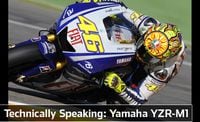Design never sits still, especially in racing. Every year at Valencia—the final event of the MotoGP season—Yamaha presents a review of current technical developments.
It's normal to seek more power and a better powerband, and to apply that power more usably through electronic controls. This past year, there was an added complication: a new rule requiring use of no more than five engines for the last seven events. The rules-makers imagined they were saving the sport money but, as usual, the result is the opposite. The easy response to the engine rule would be to chop a thousand revs off the top and get on with it. That would cut peak piston acceleration by 10 percent and, by postponing the first appearance of piston cracking (currently The Biggie in engine durability), achieve the necessary extra reliability.
But cutting your team's rpm is unilateral disarmament—no way to win races. Yamaha engineers knew that piston cracking rate is strongly temperature dependent, so they created a computer model of piston thermal behavior then validated their model by on-bike data-gathering at a test in Sepang, Malaysia. Using this, they cut piston peak temperature by a whacking 30 degrees Celsius–and doubled piston life.
They also used their motorcycle vehicle-dynamics model to optimize chassis dimensions and cg location for the new Bridgestone "control tire." If you've seen the Yamahas run, you've noticed their uncanny stability—especially by comparison with the frantic-looking Ducatis. It's no accident.
Many other details have been changed: combustion-chamber shape, airbox, aerodynamics, power and torque. Even clutch friction in "slip phase" has been studied to achieve stronger starts. Wheelie control now anticipates a wheelie by pitch-up rate rather than by waiting for front suspension to extend.These are just the work Yamaha is willing to talk about. I wonder what else there is?











/cloudfront-us-east-1.images.arcpublishing.com/octane/QSS5DZ6SKJEU3AKE4KDAWYBEFY.jpg)
/cloudfront-us-east-1.images.arcpublishing.com/octane/SMCEQCLWRVEFTJJES6TAHB3OOQ.jpg)
/cloudfront-us-east-1.images.arcpublishing.com/octane/JCACIDCAC5FUNPTXO2BOUHGGII.jpg)
/cloudfront-us-east-1.images.arcpublishing.com/octane/DC7ZGILA2BCJXHZIUNYGV7JSEA.jpg)
/cloudfront-us-east-1.images.arcpublishing.com/octane/EWJEZUGWEZGABDEQWB64WL46GQ.jpg)
/cloudfront-us-east-1.images.arcpublishing.com/octane/5NHBMRMSFVD5JAPFNMBMNPGXQE.jpg)
/cloudfront-us-east-1.images.arcpublishing.com/octane/WHE43SCPLJBRNANAJAGXHOAIEU.jpg)
/cloudfront-us-east-1.images.arcpublishing.com/octane/6R56AQAW6NDE7BBIJ3SMCOOY5A.jpg)
/cloudfront-us-east-1.images.arcpublishing.com/octane/JMQTUE2FKZFURJTJXDMM4V47AQ.jpg)
/cloudfront-us-east-1.images.arcpublishing.com/octane/P2QYJDMQNVEANMQFXHNB3OVFKQ.jpg)
/cloudfront-us-east-1.images.arcpublishing.com/octane/VNKGXM4AA5BPRGERJOPV6GADAQ.jpg)
/cloudfront-us-east-1.images.arcpublishing.com/octane/2WS4YIFLTNG25L25WP7ZFLSWJM.jpg)
/cloudfront-us-east-1.images.arcpublishing.com/octane/UXRS6ZVQZFC23FY2EDYNT5WMVA.jpg)
/cloudfront-us-east-1.images.arcpublishing.com/octane/7JETMCKNVRGDZIGB3JCITGLPUU.jpg)
/cloudfront-us-east-1.images.arcpublishing.com/octane/OZV6E2KNIJDVHGOKXQQ2AHKLHQ.jpg)
/cloudfront-us-east-1.images.arcpublishing.com/octane/XSKMIBFZIZDN7JC6P7SMNMD3QA.jpg)
/cloudfront-us-east-1.images.arcpublishing.com/octane/ITVHWHVQ75BQBHACERYDJLPLHE.jpg)
/cloudfront-us-east-1.images.arcpublishing.com/octane/M3QRBSQ4VFEVPKYTTM3OETVFBU.jpg)
/cloudfront-us-east-1.images.arcpublishing.com/octane/H3EMT5NJ5BDZPBBH27SW3ADQH4.jpg)
/cloudfront-us-east-1.images.arcpublishing.com/octane/XTROSHDZFJB5DIJYU2VF2REFIU.jpg)
/cloudfront-us-east-1.images.arcpublishing.com/octane/7EUSM4GQEBEFTPAYZ6MOMKMMUQ.jpg)
/cloudfront-us-east-1.images.arcpublishing.com/octane/ZN44KZLHD5CHVIY3WZYAGTPGSI.jpg)
/cloudfront-us-east-1.images.arcpublishing.com/octane/5A776WXBY5GAPDYFTTUEUZNIJA.jpg)
/cloudfront-us-east-1.images.arcpublishing.com/octane/NCYHFQ2S3BAT7EC7VDN2ONGRTU.jpg)